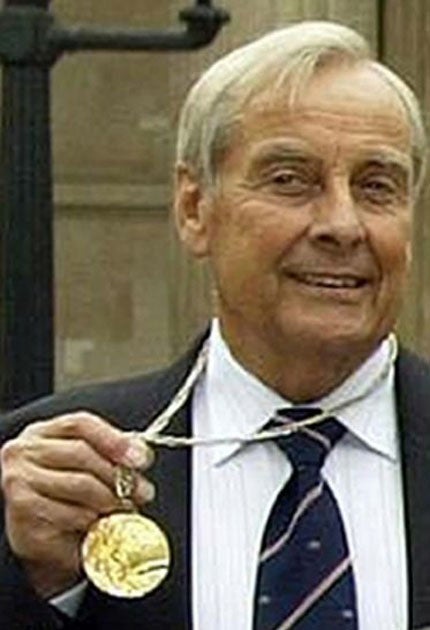Reg White: Yachtsman and boat-builder who won Olympic gold in 1976

Reg White was one of Britain's best known yachtsmen as well as an internationally renowned boat-builder. He partnered John Osborn at the 1976 Montreal Olympics, winning gold with a day of racing to spare, and dominated the world of catamarans for nearly three decades, winning three World Championships in the 1970s and the Little America's Cup a record five times between 1963 and 1968. Much to White's regret, he was unable to defend his Olympic title in Moscow in 1980 as the British sailing team withdrew in protest at the Soviet Union's invasion of Afghanistan.
Born into a family of oyster merchants in Brightlingsea, Essex in 1935, Reginald James White grew up on the Colne estuary. His learning began when he rowed his father Bert's rowing skiff, used to transport oysters ashore, which he rigged with a home-made spar and sails. He was bitten by the nautical bug.
On leaving school at 15, White secured an apprenticeship with the boat-builders James & Stone. He learned quickly and at 21 had his own business. Four years later this became Sailcraft, manufacturers of fast sailing dinghies whose reputation for design and quality would become global. During this period White also raced, with some success, his fathers, Brightlingsea One-Design (BOD) Tiller Girl, named after the dance troupe of which his sister, Pam, was a member. Later he built two Hornet class dinghies for himself and his friend Ken Howe, and within days of launching his own boat finished sixth in the World Championships at Plymouth.
While racing his Hornet he met Roy Bacon, a catamaran enthusiast who persuaded him to build a 16ft hard-chined prototype catamaran. Bacon then encouraged the multihull designer Rod Macalpine-Downie to move to Brightling-sea, where Sailcraft became the builders of all his designs, starting with the Thai Mk IV, the Shark and the Iroquois 30ft cruiser; these became the first mass-produced glass fibre catamarans and earned international acclaim.
During the 1950s Brightlingsea became the hub of multihull sailing in Britain, and John Fisk, a member of the fledgling multihull committee within the International Yacht Racing Union (IYRU), inspired by the America's Cup, approached Macalpine-Downie and White to design and build a 25ft catamaran to challenge the Eastern Multihull Association from the US to a match. In 1961, Fisk set up the event, which he called a "little America's Cup", (or International Catamaran Challenge Trophy as it is formally named).
The team at Sailcraft came up with an idea for a wing and soft-sail rig for a revolutionary high-speed catamaran. The result, Lady Helmsman, was built from cellular foam and plywood and could make nine knots without sails. The team triumphed in 1966 and won the Cup for three consecutive years, and their wingsail became a forerunner for the wing mast that helped BMW Oracle win the America's Cup in February.
White's enthusiasm for multihulls was widely known and in 1967 he was approached by the designer Rodney March to help with the first Olympic-class catamaran. Two years later the boat, the Tornado, was beating all-comers. It took off when White and March competed in a transatlantic race from the Post Office Tower to the Empire State Building, and returned with global orders for 60 Tornadoes and Sharks.
In 1971 the Tornado was selected as a new class for the 1976 Montreal Olympics. In preparation White teamed up with his brother-in-law, John Osborn, who had crewed for him on Lady Helmsman. They won the Tornado World Championships in 1976 before dominating the Olympics at Kingston, Ontario, to clinch the first Tornado gold medal with a race to spare. Soon afterwards they were appointed MBE.
White won his second Tornado World Championship title in 1979 but was unable to defend his Olympic title in Moscow due to the British team's withdrawal. Thereafter, he handed over the reins to his son Robert, who won two Tornado European Championships and two World Championships.
White continued to develop boats with Macalpine-Downie and built two successful offshore racing catamarans for Robin Knox-Johnston: the 70ft British Oxygen, then the largest racing catamaran, which won the 1974 two-man Round Britain Race, and British Airways II in which Knox-Johnston won the World Championship in 1985. With the 1990s recession Sailcraft went under, but White started a new venture, White Formula. He teamed up with the French Olympic gold medallist Yves Loder to develop a new range of catamarans, including the Spitfire and Hurricane.
White died of a heart attack while racing his new 18ft Brightlingsea One-Design, White Spirit, at Brightlingsea. He had just completed a pursuit race with his grandson Fred and his long-time crew, Stephen Olle.
Reginald White, boatbuilder and yachtsman: born Brightlingsea 28 October 1935; married 1954 Lyn Osborne (three sons, one daughter); MBE; died Brightlingsea 27 May 2010.
Subscribe to Independent Premium to bookmark this article
Want to bookmark your favourite articles and stories to read or reference later? Start your Independent Premium subscription today.

Join our commenting forum
Join thought-provoking conversations, follow other Independent readers and see their replies